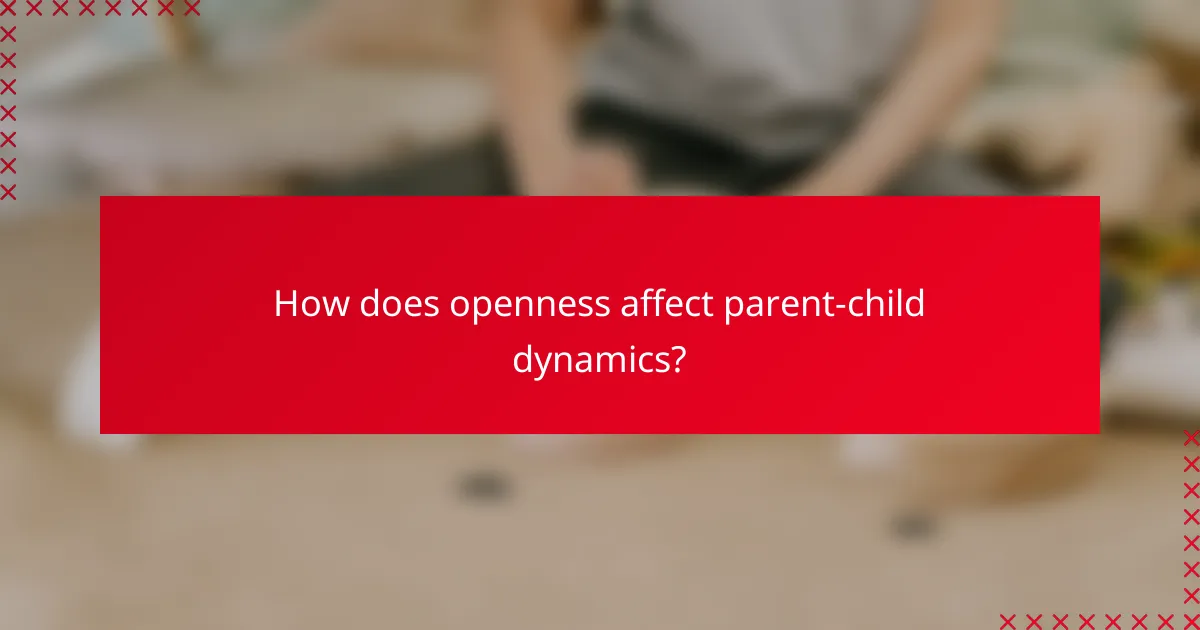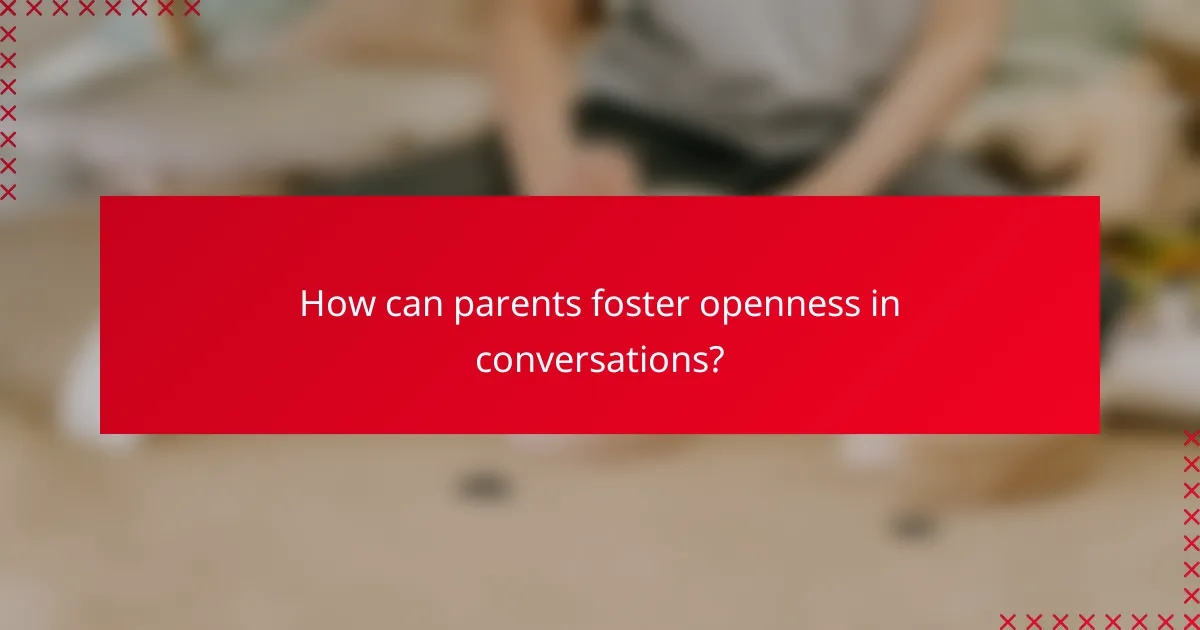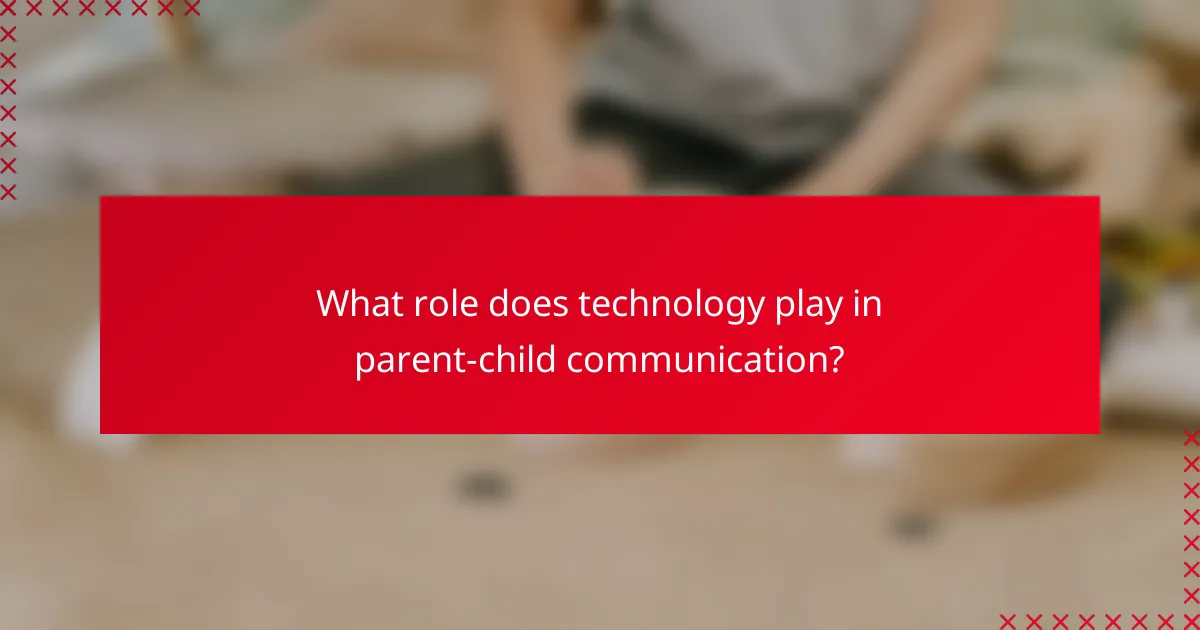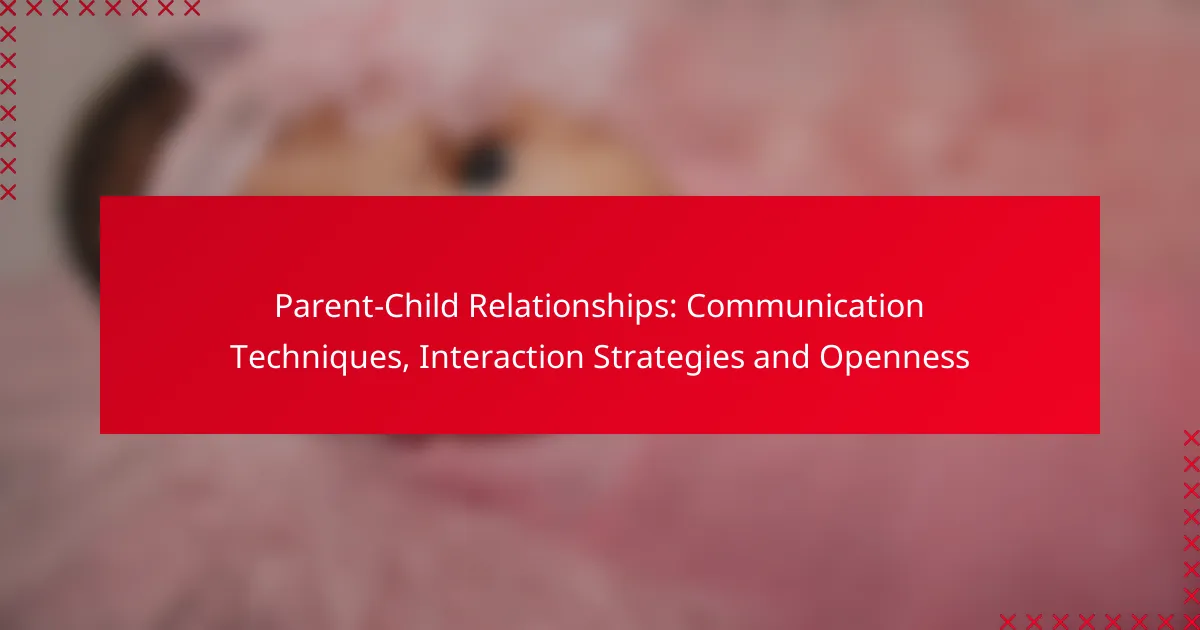Effective communication is vital for nurturing strong parent-child relationships, as it fosters understanding and openness. By employing techniques such as active listening and creating a safe environment for dialogue, parents can encourage their children to express their feelings and thoughts. This openness not only strengthens emotional bonds but also promotes mutual respect and healthy development.

How can parents improve communication with children?
Parents can enhance communication with their children by employing effective techniques that foster understanding and openness. This involves actively listening, asking the right questions, and creating a safe environment for dialogue.
Active listening techniques
Active listening is crucial for effective communication. It involves fully concentrating on what the child is saying, rather than just passively hearing their words. Parents can show they are engaged by nodding, maintaining eye contact, and summarizing what the child has expressed.
To practice active listening, parents should avoid interrupting and instead allow their children to finish their thoughts. This encourages children to share more openly and feel valued in the conversation.
Open-ended questions
Open-ended questions encourage children to express their thoughts and feelings more freely. Instead of asking questions that can be answered with a simple ‘yes’ or ‘no’, parents should frame questions that require elaboration, such as “What was the best part of your day?”
This technique not only promotes deeper conversations but also helps children develop critical thinking skills as they articulate their responses. Parents can practice this by following up with additional questions based on the child’s answers to keep the dialogue flowing.
Non-verbal communication cues
Non-verbal communication plays a significant role in how messages are received. Parents should be mindful of their body language, facial expressions, and tone of voice, as these can convey messages just as powerfully as words.
For instance, a warm smile or an open posture can signal to a child that they are safe to express themselves. Parents should also pay attention to their children’s non-verbal cues, such as gestures or facial expressions, which can provide insight into their feelings and thoughts.
Regular family meetings
Holding regular family meetings can create a structured environment for open communication. These meetings provide a platform for discussing family matters, sharing concerns, and celebrating achievements.
Setting a consistent schedule, such as weekly or bi-weekly, helps establish a routine where everyone knows they can voice their thoughts. Parents should encourage participation from all family members, ensuring that everyone feels heard and respected.
Establishing trust and safety
Building trust and a sense of safety is essential for effective communication. Parents should create an environment where children feel comfortable sharing their feelings without fear of judgment or punishment.
This can be achieved by being approachable, validating their emotions, and responding calmly to their concerns. When children trust their parents, they are more likely to engage in open and honest conversations, leading to stronger relationships.

What interaction strategies enhance parent-child relationships?
Effective interaction strategies are essential for nurturing strong parent-child relationships. These methods foster open communication, mutual respect, and understanding, which are crucial for healthy development.
Positive reinforcement methods
Positive reinforcement involves acknowledging and rewarding desirable behaviors in children. This can include verbal praise, small rewards, or extra privileges when a child meets expectations. For example, if a child completes their homework on time, a parent might offer a fun outing as a reward.
Using positive reinforcement consistently helps children feel valued and encourages them to repeat good behaviors. It’s important to be specific about what behavior is being praised to reinforce the desired action effectively.
Setting boundaries and expectations
Establishing clear boundaries and expectations is vital for children to understand acceptable behavior. Parents should communicate rules clearly and consistently, ensuring that children know what is expected of them. For instance, setting a curfew can help children learn responsibility and time management.
When boundaries are enforced fairly, children feel secure and are more likely to respect the limits set by their parents. It’s crucial to involve children in discussions about these boundaries to foster a sense of ownership and understanding.
Collaborative problem-solving
Collaborative problem-solving encourages parents and children to work together to address challenges. This approach involves discussing issues openly and brainstorming solutions as a team. For example, if a child struggles with schoolwork, parents can sit down with them to explore different study methods or resources.
This strategy not only helps resolve conflicts but also teaches children critical thinking and negotiation skills. Parents should remain open-minded and supportive during these discussions to promote a positive atmosphere.
Quality time activities
Spending quality time together strengthens parent-child bonds and enhances communication. Engaging in activities such as playing games, cooking, or going for walks allows for relaxed interaction and deeper conversations. Aim for at least a few hours each week dedicated to these activities.
Quality time should be free from distractions like phones or television to ensure meaningful engagement. Parents can ask open-ended questions during these moments to encourage children to express their thoughts and feelings more freely.

How does openness affect parent-child dynamics?
Openness in parent-child relationships fosters better communication and understanding. It encourages children to express their feelings and thoughts, leading to stronger emotional bonds and healthier interactions.
Encouraging emotional expression
Encouraging emotional expression allows children to articulate their feelings, which is essential for their emotional development. Parents can create a safe space by actively listening and validating their child’s emotions without judgment.
Simple techniques include asking open-ended questions and sharing personal feelings to model emotional honesty. For instance, instead of asking, “Are you sad?” try “What are you feeling right now?” This invites deeper conversation.
Building resilience through honesty
Honesty in communication helps children develop resilience by preparing them for real-life challenges. When parents share appropriate truths about difficulties, it teaches children how to cope with adversity and understand that setbacks are part of life.
For example, discussing family financial changes or personal struggles can help children learn problem-solving skills. This transparency fosters a sense of security and equips them to handle future challenges with confidence.
Impact of transparency on trust
Transparency between parents and children significantly enhances trust. When parents are open about their thoughts and feelings, children feel more secure in sharing their own, leading to a more trusting relationship.
To build this trust, parents should consistently communicate openly and follow through on promises. Avoiding secrets or misleading information is crucial, as children are quick to sense inconsistencies, which can damage trust over time.

What are the prerequisites for effective communication?
Effective communication in parent-child relationships requires understanding, patience, and adaptability. Parents must be aware of their child’s developmental stage and individual communication style to foster open dialogue.
Understanding developmental stages
Children progress through various developmental stages, each characterized by unique communication needs and abilities. For instance, toddlers may express themselves through gestures and simple words, while teenagers often seek deeper discussions about their feelings and opinions.
Recognizing these stages helps parents tailor their communication approaches. For example, using simple language and visual aids can enhance understanding for younger children, whereas engaging in respectful debates can be more effective with adolescents.
Recognizing individual communication styles
Every child has a distinct communication style influenced by their personality, experiences, and environment. Some children may be more expressive and vocal, while others might prefer listening and reflecting before responding.
To improve communication, parents should observe and adapt to their child’s style. For instance, a child who is more introverted may benefit from one-on-one conversations in a comfortable setting, while an extroverted child might thrive in group discussions. Understanding these preferences can significantly enhance the quality of interactions.

How can parents foster openness in conversations?
Parents can foster openness in conversations by creating a safe space where children feel comfortable expressing their thoughts and feelings. This involves active listening, validating emotions, and encouraging honest dialogue without fear of judgment.
Creating a judgment-free environment
To create a judgment-free environment, parents should actively listen to their children without interrupting or criticizing. This means acknowledging their feelings and thoughts, even if they differ from your own. Use phrases like “I understand how you feel” to show empathy and support.
Establishing ground rules for discussions can also help. For example, agree that all opinions are valid and that the conversation is a safe space for sharing. This can encourage children to speak freely about their concerns or experiences.
Modeling vulnerability
Modeling vulnerability involves parents sharing their own thoughts and feelings openly. When parents express their emotions and discuss their challenges, it demonstrates that it is okay to be imperfect and to seek support. This can encourage children to do the same.
Parents can share age-appropriate stories about their own experiences, including mistakes and lessons learned. This not only builds trust but also shows children that everyone faces difficulties and that talking about them is a healthy practice.

What role does technology play in parent-child communication?
Technology significantly enhances parent-child communication by providing various platforms and tools that facilitate interaction. Through messaging apps, video calls, and social media, families can maintain connections and share experiences, regardless of distance.
Utilizing apps for family connection
Apps designed for family communication can streamline interactions and foster closer relationships. Popular options include messaging platforms like WhatsApp or family-oriented apps like FamilyWall, which allow for shared calendars, photo albums, and group chats.
When choosing an app, consider factors such as user-friendliness, privacy settings, and the ability to share multimedia content. It’s essential to ensure that all family members are comfortable with the technology to encourage regular use.
To maximize the benefits, set aside specific times for family video calls or group chats, and encourage children to share their daily experiences through the app. This can create a routine that strengthens bonds and keeps everyone engaged.
